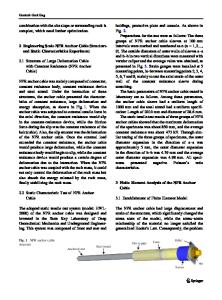Numerical Analysis of Free-Edge Effect on Size-Influenced Mechanical Properties of Single-Layer Triaxially Braided Compo
- PDF / 1,500,684 Bytes
- 19 Pages / 439.37 x 666.142 pts Page_size
- 99 Downloads / 268 Views
Numerical Analysis of Free-Edge Effect on Size-Influenced Mechanical Properties of Single-Layer Triaxially Braided Composites Chao Zhang & Wieslaw K. Binienda
Received: 20 November 2013 / Accepted: 13 January 2014 # Springer Science+Business Media Dordrecht 2014
Abstract The mechanical properties of triaxially braided composites under transverse loads are found to be size-dependent, due to the presence of free-edge effect. Numerical studies of the mechanical behaviors of straight-sided coupon specimens and an infinitely large plate under both axial and transverse tension loads were conducted using a meso-scale finite element model. The numerical model correlates well with experimental results, successfully capturing the free-edge warping phenomena under transverse tension. Free-edge effect is observed as out-of-plane warping, and it can be correlated to the premature damage initiation in the affected area. The numerical results characterize the impact of free-edge effects on the global stress–strain response and local failure mechanisms. By conducting dimensional analysis, the relationships of effective stiffness and strength against specimen width are quantified using Weibull equations. The results of this study indicate that the free-edge effect is an inherent behavior of braided architecture. The free-edge effect produces significantly reduced transverse tension modulus and strength measurements. Keywords Triaxially braided composites . Free-edge effect . Mechanical properties . Finite element analysis (FEA) . Damage mechanics
1 Introduction Composite materials are widely used as structural components in aerospace, automotive, marine and sport recreation products due to their outstanding physical, mechanical and thermal properties, especially their high stiffness and strength-to-weight ratios. Composite materials display strength characteristics that are similar to those of brittle ceramics, whose strengths are known to decrease with increasing volume for a uniform state of stress (size effect) and also are dependent on the stress distribution [1]. A number of authors have considered the question of size effects in composites [2–4]. It is reported that the mean tensile strength [5], compressive strength [6] and flexural strength [7] of unidirectional composite coupon type specimens decrease with an increase in specimen size (or larger volume). C. Zhang (*) : W. K. Binienda Department of Civil Engineering, The University of Akron, Akron, OH 44325, USA e-mail: [email protected]
Appl Compos Mater
Wisnom [8] offered a comprehensive discussion on the factors influencing size effects. Based on statistical consideration (weakest-link theory), larger volumes have a higher probability of containing a larger defect, giving rise to size effect as the strength of a chain is determined by its weakest link. In addition, the microstructure of a composite is important in determining the defects that may give rise to size effect, such as flaws in the microstructure of fibers, transverse cracks, or local undulation of fi
Data Loading...











